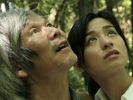Eye For Film >> Movies >> The Mourning Forest (2007) Film Review

There are two ways of being alive, the master says. The first is doing routine things like eating and drinking. The second is experiencing sensations and having emotional reactions to them - feeling alive.
Machiko (Machiko Ono) hasn't felt alive since the death of her son. "If you hadn't let go of his hand, he would still be alive," her husband says. Perhaps that's why she has retreated into a quiet role as a carer in an old people's home. There she meets Shigeko (Shigeki Uda), who is losing his sense of being alive to the isolating effects of dementia. One day, Machiko and Shigeki become stranded in the forest. The journey that follows will help them both to rediscover who they are, as Shigeki searches for something connected to his dead wife and Machiko has to take on the responsibility of looking after him as if he were a child, in the process facing what she most fears.

In lesser hands, this could have been unbearably twee, but director Naomi Kawase approaches it with a sincerity and grace that make it both believable and magical. It's steeped in the idea of shinrin-yoku, or forest bathing, whereby closeness to nature restores perspectives all too lost in modern human society. The master, consulted at the outset, holds that society is responsible for creating loneliness. It's only out in the wilds, isolated as they are, that the two central characters begin to shed their loneliness. A scene involving a stolen watermelon, a culturally potent metaphor for flesh and sexuality, implies a return to a state in which the demands of that first way of being alive dominate. No longer worrying about how they ought to feel or react, Machiko and Shigeki begin to connect with their environment and with one another in new ways.
Immersing us in this environment takes skill. The cultivated fields do not seem far from civilisation. Even in the forest there are pathways and signs. But traversing all this is complicated for an elderly men in a way that it might not be for others. Pouring rain presents another hazard, making him dangerously cold. Kawase's camera loves the water, whether rain, dew, light mist or spray from a tumbling stream. This adds to the richness of plants and earth so we can almost smell them. Muted light adds to the sense of intimacy in this outdoor space, in a film that is as much about the interior.
The two leads are both well chosen, delivering finely balanced performances. Kawase's observational style gives them plenty of room to work. In one scene, the camera lingers on Machiko's face as she strains for air under the weight of her grief. The film is quiet, even gentle in its pacing, but has a great deal to say.
Reviewed on: 20 Aug 2017
















